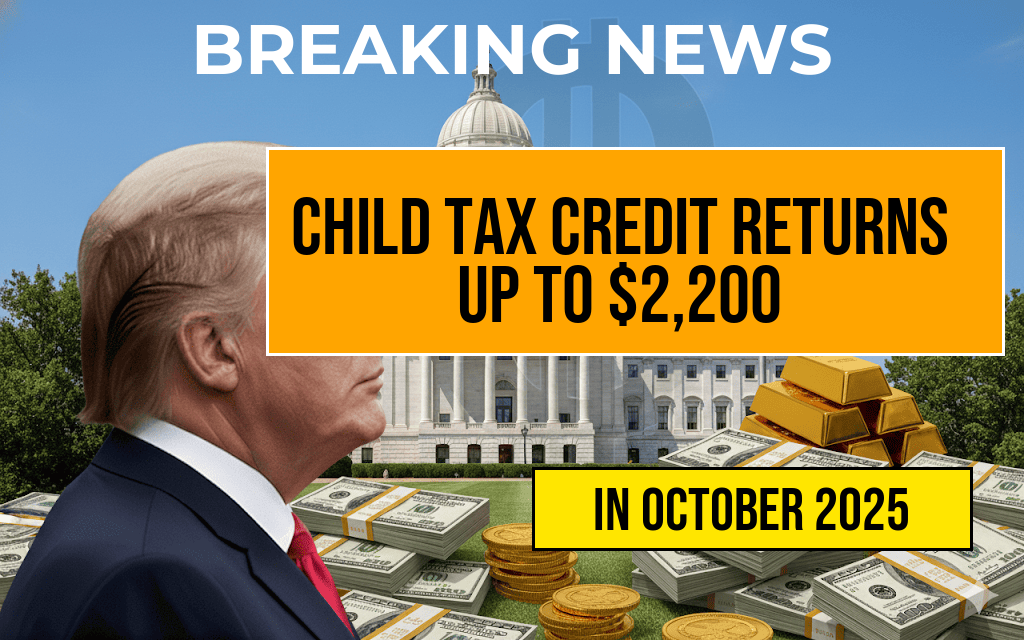The Internal Revenue Service (IRS) is offering a significant opportunity for eligible families to receive up to $1,700 through the Child Tax Credit (CTC) refund program. This initiative aims to provide financial relief to households with qualifying children, especially those who may not have claimed the full amount in previous years. Recent adjustments to the program, including expanded eligibility and increased income limits, have opened the door for many families to access these funds. But understanding the eligibility criteria, application process, and potential benefits can be complex, prompting many to explore whether they qualify before the upcoming tax season.
Understanding the Child Tax Credit Refund Opportunity
What Is the Child Tax Credit?
The Child Tax Credit is a federal benefit designed to assist families with the costs of raising children under the age of 17. Traditionally, the credit has been used to reduce the amount of tax owed, but recent changes have introduced refundable components, allowing families to receive payments even if they do not owe taxes. The American Rescue Plan Act of 2021 significantly expanded the CTC, increasing the maximum credit amount and making it fully refundable for many families. This expansion was temporary but has been extended through 2025, providing ongoing opportunities for eligible households.
How Much Can Families Claim?
| Number of Qualifying Children | Maximum Refundable Amount |
|---|---|
| 1 | $1,700 |
| 2 | $3,400 |
| 3 or more | Up to $5,100 |
Families with one eligible child could potentially receive a refund of up to $1,700, which is a significant boost for household budgets. The amount varies based on income, filing status, and the number of qualifying children.
Who Qualifies for the Refund?
Eligibility criteria for the expanded Child Tax Credit include:
- Children under age 17 at the end of the tax year
- Valid Social Security numbers for both parent and child
- Household income below specific thresholds, which are adjusted annually
- Filing status such as single, married filing jointly, head of household, etc.
For 2023, the income limits for full credit phase-out begin at $75,000 for single filers and $150,000 for married couples filing jointly. Families with incomes above these thresholds may receive reduced refunds or may not qualify at all.
How Can Families Claim the Refund?
Most eligible families can claim the Child Tax Credit when filing their federal tax returns using IRS Form 1040 or 1040-SR. The IRS has also implemented advance payments, distributing half of the estimated credit amount periodically throughout 2021 and 2022, with some families still eligible for additional refund amounts upon filing. To maximize the benefit, families should ensure their information is accurate and up-to-date, including Social Security numbers and income details.
Additional resources and guidance are available on the [IRS website](https://www.irs.gov/credits-deductions/child-tax-credit) and through free tax preparation programs for qualifying households.
Key Considerations and Next Steps
Checking Eligibility and Avoiding Common Pitfalls
Families should verify their eligibility before claiming the refund to avoid delays or denials. Common pitfalls include incorrect Social Security numbers, inaccurate income reporting, or failing to update personal information. The IRS provides an online Child Tax Credit Eligibility Tool to help families determine their qualification status.
Recent Changes and Future Outlook
The Child Tax Credit program continues to evolve, with legislative proposals aiming to extend its expanded features beyond 2025. Families are encouraged to stay informed about eligibility rules and deadlines, as failing to claim the credit in time could result in missed opportunities. The IRS regularly updates its guidance, especially in response to policy shifts or economic changes.
Additional Support Options
Beyond the Child Tax Credit, families may qualify for other assistance programs, including the Earned Income Tax Credit (EITC) and the Child and Dependent Care Credit. Combining these benefits can further ease financial burdens for low- and moderate-income households. For detailed information on available programs, consult resources such as [Benefits.gov](https://www.benefits.gov/).
Frequently Asked Questions
What is the Child Tax Credit?
The Child Tax Credit is a government benefit designed to provide financial assistance to families with qualifying children, helping to offset the costs of raising a child.
How much can I potentially claim from the Child Tax Credit?
You may be eligible to claim up to $1,700 per qualifying child, depending on your income and family situation.
Who qualifies for the Child Tax Credit refund?
Qualifying families are those with children under age 17, who meet income requirements, and have filed a tax return to claim the Child Tax Credit.
How do I apply for the Child Tax Credit refund?
You can apply for the refund by filing a tax return and claiming the Child Tax Credit. Ensure all information is accurate to maximize your refund potential.
When can I expect to receive the refund?
Refunds are typically processed after your tax return is filed, with payments issued within a few weeks, depending on the IRS processing times.








